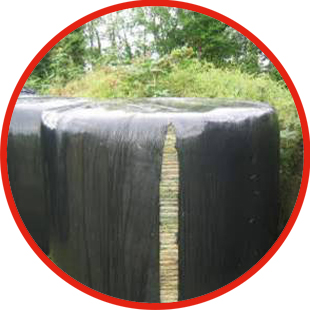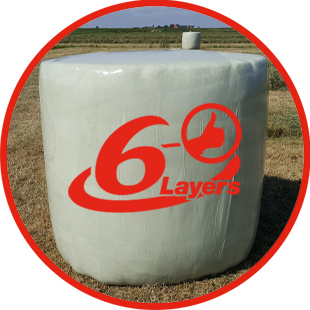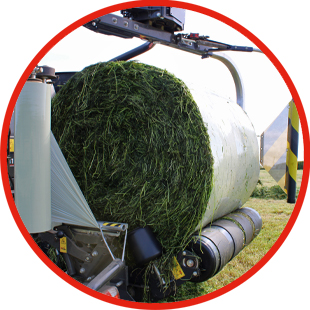
Balewrapper settings vary according to manufacturer and the terminology for “number of layers” is often different.
To know for certain how many layers of film are on your bale, begin by making an approximate 10cm² incision from the barrel of the wrapped bale. It is important not to take the sample from the ends of the bale, as these receive more layers of overlap.
Apply tape to two of your fingers, with the adhesive sides upwards, and pull apart and the individual layers from the sample. Count these and adjust machine settings if necessary.

A common issue encountered with baled silage is the film splitting post-wrapping. Here, we look at the causes and solutions. Splitting can occur weeks, even months, after the wrapping is done and is most likely to occur with wet, heavy bales. Unless these bales have been carefully wrapped with a quality balewrap, they are likely to burst after handling, transport, stacking, and during storage.

Opting for a poor quality balewrap can have negative costly effects on silage production. A high quality balewrap requres a balanced mix of characteristics; namely high film strength, tear resistance, puncture resistance, elasticity, cling capacity and UV inhibitors.
It is essential to use a quality brand, such as Silotite, which has been tried and tested in the field. Silotite's Pro range of films are manufactured using the latest multilayer extrusion technology. Our patented (No. EP2193026.) Pro technology conditions and compacts the film during the manufacturing process, producing a lightweighted silage stretchfilm, while keeping the mechanical strength, oxygen permeability and airtightness at the same level.

Film splitting can also be caused by insufficient film coverage on the bale. Contractors must fully brief new and less experienced employees on the importance of applying enough turns to the bale to achieve complete coverage. We recommend six film layers with a minimum of 50 percent overlap. All contractors must also be aware of, and follow, machinery manufacturer's guidelines.
Before baling, it is always a good idea to lift and spread the grass with a tedder or a rake. Ensure the swath is the same height and depth across the full width when entering the mouth of the baler – this ensures production of firm and well-shaped bales. Avoid cutting grass to low, as this can cause soil contamination.

All bale-wrapper manufacturers recommend the following guidelines:
1. Count the number of turns required to completely cover the bale;
2. Add one extra turn (to compensate for the narrowing of the film from the start of the cycle, when the film is held in the cut-and-catch mechanism);
3. Multiply this number by two for four film layers or by three for six film layers.

Valérien Pierron, Head of Sales for the CEUMA-S regions, explains the importance of moving bales soon after wrapping.
“We always recommend to move bales as quickly as possible after wrapping. This ideally means within 2 hours, but where this isn’t practical, you should certainly aim to move them within 8 hours. Once at the storage site, the bales should then be left in place until they’re ready to be fed out.
The fermentation process begins quickly after the bale has been wrapped. Disturbing this process by moving the bale after it has settled for too long may cause oxygen to enter between the layers of film, promoting mould growth.”
